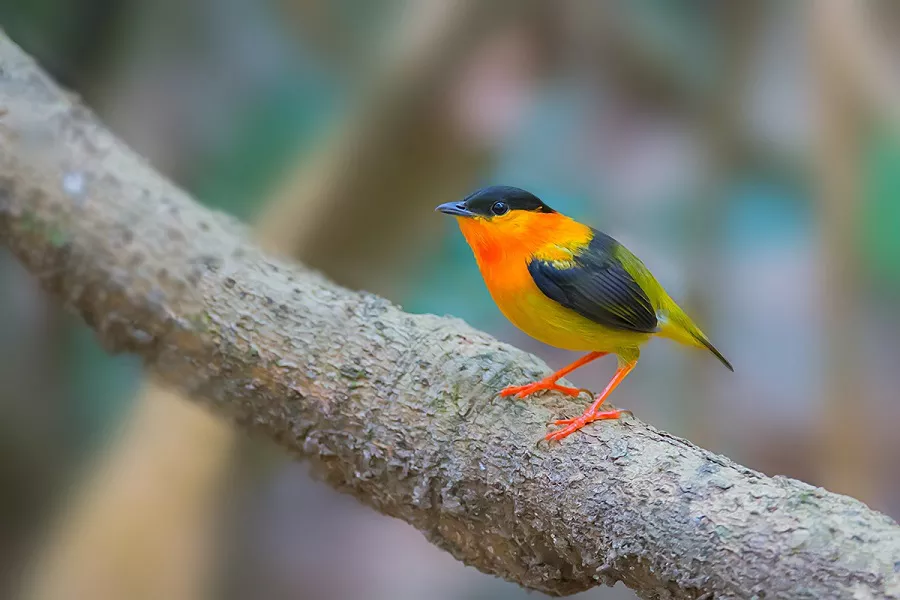The Orange-Collared Manakin (Manacus aurantiacus) is a small passerine bird found in the tropical rainforests of Central and South America. With its vibrant colors and extraordinary courtship display, the Orange-collared Manakin has captured the attention and fascination of bird watchers and researchers alike. In this article, we will explore in detail the physical characteristics, behavior, and habitat of this captivating bird.
Physical Characteristics of the Orange-Collared Manakin
The Orange-Collared Manakin is a small, yet strikingly colorful bird, measuring around 4.5 to 5.1 inches in length. Its distinctive appearance is highlighted by its namesake feature – a vibrant orange collar that encircles its neck, giving the species its unique identifier. Males and females exhibit marked differences in plumage. While the males boast a stunning combination of brilliant orange and jet black feathers, the females showcase a more subdued olive-green hue with a paler orange collar. This sexual dimorphism is a common phenomenon in many avian species and serves as an adaptation for their specific roles in reproduction and survival.
Distribution and habitat of the Orange-collared Manakin
The Orange-Collared Manakin inhabits the lowland rainforests and humid environments of Central and South America. Its range extends from southern Mexico down to parts of Brazil and Ecuador. These lush and vibrant ecosystems provide the ideal backdrop for the bird’s stunning plumage, allowing it to seamlessly blend into the tapestry of colors that define the rainforest. This habitat preference also underscores the importance of conserving these ecosystems, as they are not only critical for the survival of the Orange-Collared Manakin but for a myriad of other species as well.
Behavior and Mating Rituals
Beyond its striking appearance, the Orange-Collared Manakin is known for its captivating and elaborate courtship rituals. Males of this species engage in an intricate display known as “lekking,” where they gather in groups to perform synchronized and acrobatic dances. These performances are a spectacle to behold, with the males leaping, fluttering, and producing distinct mechanical sounds with their wings, all while competing for the attention of the less conspicuous females. This behavior not only showcases the male’s physical prowess but also highlights their role in attracting potential mates.
Diet and Feeding Habits
The Orange-Collared Manakin’s diet consists primarily of fruit, nectar, and insects, reflecting its adaptability to its rainforest habitat. The consumption of fruit and nectar makes the bird an essential player in the ecological network of its environment, as it contributes to seed dispersal and pollination. Insects, on the other hand, provide a protein-rich food source that is essential for the bird’s growth and reproduction. This versatile diet highlights the Orange-Collared Manakin’s ecological significance within its ecosystem.
Conclusion
In the grand tapestry of the avian world, the Orange-Collared Manakin stands out as a testament to nature’s creativity and beauty. Its vibrant plumage, elaborate courtship rituals, and ecological significance make it a species deserving of our admiration and protection.
FAQs About The Orange-Collared Manakin
Here are some frequently asked questions about the Orange-Collared Manakin:
Q: What is the Orange-Collared Manakin?
A: The Orange-Collared Manakin (Manacus aurantiacus) is a small bird species belonging to the family Pipridae, commonly known as manakins. It is found in Central and South America, inhabiting tropical and subtropical forests.
Q: What is the behavior of the Orange-Collared Manakin like?
A: Male Orange-Collared Manakins are known for their unique courtship displays. They gather in small leks, where multiple males perform synchronized and acrobatic dances to attract females. These dances involve rapid wing movements, flips, and jumps. The females select their mates based on the quality of these displays.
Q: What is the habitat of the Orange-Collared Manakin?
A: Orange-Collared Manakins inhabit tropical and subtropical lowland forests, including rainforests, evergreen forests, and secondary growth areas. They prefer dense vegetation and are often found in areas with a variety of fruiting trees.
Q: What do Orange-Collared Manakins eat?
A: Their diet primarily consists of fruits, berries, and insects. They supplement their fruit-based diet with insects and arthropods, especially during the breeding season when they need more protein.
Q: Do Orange-Collared Manakins migrate?
A: Orange-Collared Manakins are generally considered non-migratory birds. However, they might make local movements within their range in response to changes in food availability or other environmental factors.
Q: Can the Orange-Collared Manakin mimic sounds?
A: Manakins, including the Orange-Collared Manakin, are known for their ability to mimic sounds, including other bird species’ calls. This mimicking behavior is often associated with their courtship displays and may play a role in attracting females.


 Facebook
Facebook  Instagram
Instagram  Youtube
Youtube 